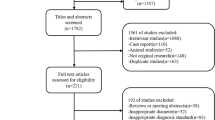Abstract
Objectives
To determine the importance of arterial enhancement in diagnosing small (<3 cm) hepatocellular carcinomas (HCCs) and to evaluate the added value of dynamic subtraction magnetic resonance imaging (MRI) in detecting arterial enhancement in small (<3 cm) hepatic nodules in high-risk patients.
Methods
Eighty-six patients with 135 pathologically confirmed small (<3 cm) hepatic nodules (104 HCCs, 31 benign nodules) underwent MRI before curative surgery. Arterial enhancement was determined by three methods: (1) visual assessment of the arterial phase alone, (2) visual comparison of the arterial phase with the unenhanced phase and (3) additional review of subtraction images. The diagnostic performance of each method was calculated and compared using generalised estimating equations analysis.
Results
Arterial enhancement demonstrated high positive predictive value (PPV) (96.5–98.9 %) and specificity (90.3–96.8 %), but low negative predictive value (NPV) (54.6–62.5 %) and intermediate sensitivity (76–79.8 %) for diagnosing small HCCs. Diagnostic performance was highest for subtraction imaging. There were significant differences among the three methods in sensitivity (P = 0.04), accuracy (P = 0.044), PPV (P < 0.001) and NPV (P = 0.024), but not in specificity (P = 0.167).
Conclusion
The accurate detection of arterial enhancement in small hepatic nodules is important for diagnosing HCC and may be enhanced by subtraction imaging.
Key Points
• Arterial enhancement in small hepatic nodules indicates a high probability of malignancy
• Dynamic subtraction MRI can enable more accurate detection of arterial enhancement
• Subtraction imaging could lead to earlier diagnosis of hepatocellular carcinoma
• More timely care for patients might be provided


Similar content being viewed by others
Abbreviations
- HCC:
-
hepatocellular carcinoma
- EASL:
-
European Association for the Study of the Liver
- AASLD:
-
American Association for the Study of Liver Diseases
- GRE:
-
gradient recalled echo
- Gd-EOB-DTPA:
-
gadolinium-ethoxybenzyl-diethylenetriamine
- PPV:
-
positive predictive value
- NPV:
-
and negative predictive value
- GEE:
-
Generalised estimating equations
References
Bruix J, Sherman M, Llovet JM et al (2001) Clinical management of hepatocellular carcinoma. Conclusions of the Barcelona-2000 EASL conference. European Association for the Study of the Liver. J Hepatol 35:421–430
Bruix J, Sherman M (2011) Management of hepatocellular carcinoma: an update. Hepatology 53:1020–1022
Nino-Murcia M, Olcott EW, Jeffrey RB Jr, Lamm RL, Beaulieu CF, Jain KA (2000) Focal liver lesions: pattern-based classification scheme for enhancement at arterial phase CT. Radiology 215:746–751
Lutz AM, Willmann JK, Goepfert K, Marincek B, Weishaupt D (2005) Hepatocellular carcinoma in cirrhosis: enhancement patterns at dynamic gadolinium- and superparamagnetic iron oxide-enhanced T1-weighted MR imaging. Radiology 237:520–528
Secil M, Obuz F, Altay C et al (2008) The role of dynamic subtraction MRI in detection of hepatocellular carcinoma. Diagn Interv Radiol 14:200–204
Yu JS, Kim YH, Rofsky NM (2005) Dynamic subtraction magnetic resonance imaging of cirrhotic liver: assessment of high signal intensity lesions on nonenhanced T1-weighted images. J Comput Assist Tomogr 29:51–58
An C, Park MS, Jeon HM et al (2012) Prediction of the histopathological grade of hepatocellular carcinoma using qualitative diffusion-weighted, dynamic, and hepatobiliary phase MRI. Eur Radiol 22:1701–1708
Winters SD, Jackson S, Armstrong GA, Birchall IW, Lee KH, Low G (2012) Value of subtraction MRI in assessing treatment response following image-guided loco-regional therapies for hepatocellular carcinoma. Clin Radiol 67:649–655
Bland JM (2004) Cluster randomised trials in the medical literature: two bibliometric surveys. BMC Med Res Methodol 4:21
Landis JR, Koch GG (1977) The measurement of observer agreement for categorical data. Biometrics 33:159–174
Ebara M, Fukuda H, Kojima Y et al (1999) Small hepatocellular carcinoma: relationship of signal intensity to histopathologic findings and metal content of the tumor and surrounding hepatic parenchyma. Radiology 210:81–88
Ebara M, Ohto M, Watanabe Y et al (1986) Diagnosis of small hepatocellular carcinoma: correlation of MR imaging and tumor histologic studies. Radiology 159:371–377
Kadoya M, Matsui O, Takashima T, Nonomura A (1992) Hepatocellular carcinoma: correlation of MR imaging and histopathologic findings. Radiology 183:819–825
Matsui O, Kadoya M, Kameyama T et al (1989) Adenomatous hyperplastic nodules in the cirrhotic liver: differentiation from hepatocellular carcinoma with MR imaging. Radiology 173:123–126
Krinsky GA, Lee VS (2000) MR imaging of cirrhotic nodules. Abdom Imaging 25:471–482
Yu J, Rofsky NM (2003) Dynamic subtraction MR imaging of the liver: advantages and pitfalls. AJR Am J Roentgenol 180:1351–1357
Sugimoto K, Moriyasu F, Shiraishi J et al (2012) Assessment of arterial hypervascularity of hepatocellular carcinoma: comparison of contrast-enhanced US and gadoxetate disodium-enhanced MR imaging. Eur Radiol 22:1205–1213
Onishi H, Kim T, Imai Y et al (2012) Hypervascular hepatocellular carcinomas: detection with gadoxetate disodium-enhanced MR imaging and multiphasic multidetector CT. Eur Radiol 22:845–854
Hayashida M, Ito K, Fujita T et al (2008) Small hepatocellular carcinomas in cirrhosis: differences in contrast enhancement effects between helical CT and MR imaging during multiphasic dynamic imaging. Magn Reson Imaging 26:65–71
Matsui O, Kadoya M, Kameyama T et al (1991) Benign and malignant nodules in cirrhotic livers: distinction based on blood supply. Radiology 178:493–497
Chefd’hotel C, Hermosillo G, Faugeras O (2002) Flows of diffeomorphisms for multimodal image registration. In: Proc IEEE Int Symp Biomed Imaging 2002, pp 753–756
Acknowledgements
This research was supported by Basic Science Research Program through the National Research Foundation of Korea funded by the Ministry of Education, Science and Technology (7-2012-0290).
Author information
Authors and Affiliations
Corresponding author
Rights and permissions
About this article
Cite this article
An, C., Park, MS., Kim, D. et al. Added value of subtraction imaging in detecting arterial enhancement in small (<3 cm) hepatic nodules on dynamic contrast-enhanced MRI in patients at high risk of hepatocellular carcinoma. Eur Radiol 23, 924–930 (2013). https://doi.org/10.1007/s00330-012-2685-x
Received:
Revised:
Accepted:
Published:
Issue Date:
DOI: https://doi.org/10.1007/s00330-012-2685-x




